
Following the release of HBO’s new miniseries, Chernobyl, the world’s worst nuclear disaster is back in the spotlight once again.
The accident, which occurred in the early morning hours of April 26, 1986, resulted in 116,000 people being evacuated from their homes.
Today, 33 years on from the disaster, the death toll from the Chernobyl disaster is still unknown.
But in the United States, there’s another nuclear threat that’s been described as “the most toxic place in America” and “an underground Chernobyl waiting to happen”.
The real story behind HBO’s Chernobyl. Post continues after podcast.
The Hanford Nuclear Site in Washington state is known as the most contaminated place in the entire Western Hemisphere.
The nuclear site, which is now decommissioned and known as the most toxic nuclear dump in the US, is where the US Federal Government started producing plutonium for the Manhattan Project.
For 45 years, during the Cold War, production continued at the site. In fact, plutonium produced at Hanford was even used to fuel the nuclear bomb dropped on Nagsaki in 1945.
Finally, in 1989, production stopped at the plant and the arduous clean up process began.
Decades later, Hanford is in the midst of America’s largest ever nuclear waste clean-up operation – and there’s still a long way to go.
The clean-up process, which is currently stalled, may continue until the 2080’s and it’s expected to cost US taxpayers more than $100 billion.
But that’s not the only problem at Hanford.


